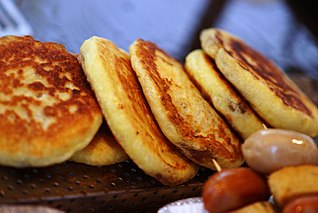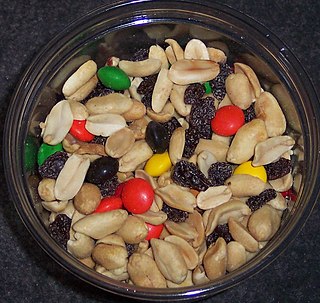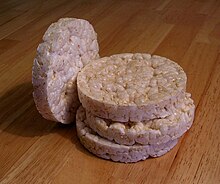Hot sand frying and hot salt frying are cooking techniques used by street-side food vendors in Bangladesh, India, Nepal, Pakistan, China and Sri Lanka. Hot salt frying is an old cooking technique, and is used in villages throughout Asia and other parts of the world. Many foods are fried with hot salt or sand, even in common households.

Mochi is a Japanese rice cake made of mochigome (もち米), a short-grain japonica glutinous rice, and sometimes other ingredients such as water, sugar, and cornstarch. The steamed rice is pounded into paste and molded into the desired shape. In Japan, it is traditionally made in a ceremony called mochitsuki. While eaten year-round, mochi is a traditional food for the Japanese New Year, and is commonly sold and eaten during that time.

Bhelpuri is a savoury snack originally from India, and is also a type of chaat. It is made of puffed rice, vegetables and a tangy tamarind sauce, and has a crunchy texture.

Bamba is a snack made of peanut-butter-flavored puffed maize manufactured by the Osem corporation in Kiryat Gat, Israel. Bamba is one of the leading snack foods produced and sold in Israel. It was introduced in 1964. Bamba makes up 25% of the Israeli snack market.

Puffed grains are grains that have been expanded ("puffed") through processing. They have been made for centuries with the simplest methods like popping popcorn. Modern puffed grains are often created using high temperature, pressure, or extrusion.
Flattened rice is a type of rice dish made from raw, toasted, or parboiled rice grains pounded into flat flakes. They are eaten as is, toasted, fried, or used as ingredients or toppings for other dishes. Depending on their use, they can be crispy, crunchy, chewy, or soft in texture with a light nutty flavor. They are traditional to many rice-cultivating cultures in Southeast Asia and South Asia. It is also known variously as rice flakes, beaten rice, pounded rice, pressed rice or chipped rice.

Puffed rice and popped rice are types of puffed grain made from rice commonly eaten in the traditional cuisines of Southeast Asia, East Asia, and South Asia. It has also been produced commercially in the West since 1904 and is popular in breakfast cereals and other snack foods.

A rice cake may be any kind of food item made from rice that has been shaped, condensed, or otherwise combined into a single object. A wide variety of rice cakes exist in many different cultures in which rice is eaten. Common variations include cakes made with rice flour, those made from ground rice, and those made from whole grains of rice compressed together or combined with some other binding substance.

Tteokbokki (Korean: 떡볶이), or simmered rice cake, is a popular Korean food made from small-sized garae-tteok called tteokmyeon or commonly tteokbokki-tteok. Eomuk, boiled eggs, and scallions are some common ingredients paired with tteokbokki in dishes. It can be seasoned with either spicy gochujang or non-spicy ganjang -based sauce; the former is the most common form, while the latter is less common and sometimes called gungjung-tteokbokki.

Sachima is a sweet snack in Chinese cuisine made of fluffy strands of fried batter bound together with a stiff sugar syrup. It originated in Manchuria and is now popular throughout China. Its decoration and flavor vary in different regional Chinese cuisines, but the appearance of all versions is essentially the same, somewhat similar to that of American Rice Krispies Treats.

Hotteok, sometimes called hoeddeok, is a type of filled pancake known as a popular street food in South Korea. It originated in China, and was first brought into Korea during the 19th century.

Yeot-gangjeong (엿강정) is a candy bar-like variety of hangwa consisting of toasted seeds, nuts, beans, or puffed grains mixed with mullyeot. In general households, they usually make and eat yeot-gangjeong during Korean holidays and Jesa. Or, it is made and sold as a winter snack and is usually eaten during holidays and feasts.

Popchips is an American brand of popped potato and corn products marketed as similar to potato chips. They are manufactured by processing potato starch at high pressure and temperature, in a process similar to that used for puffed rice cakes.

Ampaw, ampao or arroz inflado, usually anglicized as pop rice or puffed rice, is a Filipino sweet puffed rice cake. It is traditionally made with sun-dried leftover cooked white rice that is fried and coated with syrup.

A snack is a small portion of food generally eaten between meals. A snack is often less than 200 calories, but this can vary. Snacks come in a variety of forms including packaged snack foods and other processed foods, as well as items made from fresh ingredients at home.

In the Burmese language, the term mont translates to "snack", and refers to a wide variety of prepared foods, ranging from sweet desserts to savory food items that may be cooked by steaming, baking, frying, deep-frying, or boiling. Foods made from wheat or rice flour are generally called mont, but the term may also refer to certain varieties of noodle dishes, such as mohinga. Burmese mont are typically eaten with tea during breakfast or afternoon tea time.
Rice forms an important part of Korean economy and culture. Koreans have been eating rice for a long time, and it is one of the ingredients that should not be missed at meals. Therefore, there are many kinds of rice dishes, there are many local festivals related to rice, and there are many proverbs related to rice.





















